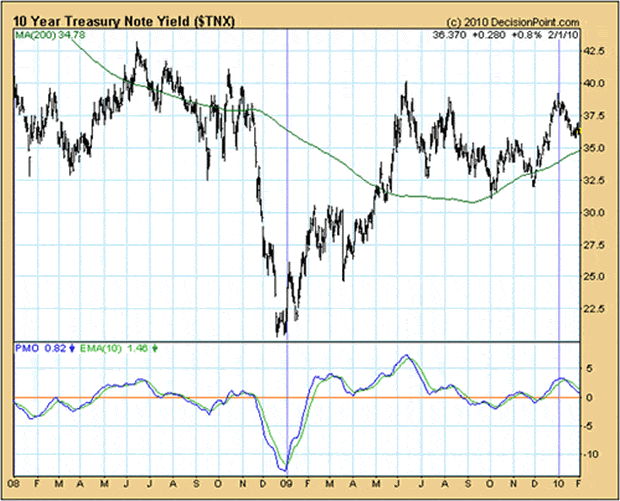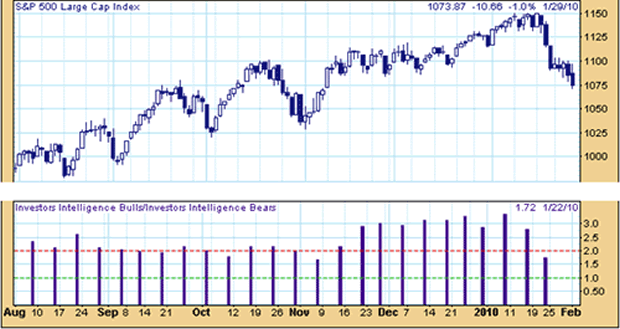Stock Market Warning Signs to Watch
Stock-Markets / Stock Markets 2010 Feb 03, 2010 - 08:45 AM GMTBy: Claus_Vogt
 The stock market does not turn on a dime. At least historically that’s been the case.
The stock market does not turn on a dime. At least historically that’s been the case.
Take Japan as an impressive example …
At 10,300 the Nikkei is now 74 percent below its all time high of December 1989. On the long way down it has experienced many cyclical rallies, some of them amounting to gains of more than 100 percent!
All of them finally failed. Yet none did so by turning on a dime. There was always a distinctive topping process going on before the bear finally struck.
Or take the secular bear market that plagued the U.S. from 1966 to 1982. Or the German secular bear market from 1960 to 1982 … or the spectacular stock market crashes of 1929 and 1987 … and you’ll detect the same pattern: A marked deterioration of market internals — and of interest rate based indicators — before the famous crashes struck.
So if history is our guide, we should not expect this time to be different. Of course there are no guarantees. But I think chances are very good that we’ll get some of the typical indications of an imminent bear market before this medium-term up trend that began in March 2009 is over.
And to pick up on those indications when they start flashing warning signals of a trend change, I’m closely watching for deterioration in three major areas …
Warning Signal #1: Macro-Economic Deterioration
 |
| The LEI increased sharply in December. |
The Conference Board’s Index of Leading Economic Indicators has an outstanding track record in giving warning signs of an imminent recession. And when it does, you can expect that a severe bear market is in the making.
As of December 2009, this indicator was up 7.7 percent year-over-year after rising 6.3 percent in November. These strong readings signal a continuation of the economic rebound for at least another two quarters.
So this indicator has not given a warning signal yet.
Warning Signal #2: Monetary Deterioration
Interest rates and monetary growth have a huge influence on the stock markets. And strongly rising rates are bearish, especially short-term ones.
The Fed has again made clear that it will keep short-term interest rates very low for an “extended period of time.”
No warning signal here.
However, with long-term rates the picture is more problematic …
As shown in the chart below, 10-year Treasury bond yields have clearly risen from the panic lows reached in December 2008. Yields doubled from December 2008 until June 2009 and have trended sideways since then.

Source: www. decisionpoint.com
If 10-year Treasury bond yields rise above the June 2009 high of 4 percent for a few months, you should expect problems for the stock market. And I predict they will rise during the coming months.
Again, no warning signal, at least not yet.
As an answer to the crisis in 2008 the Fed started printing money like there was no tomorrow. Consequently, monetary aggregates skyrocketed with double digit year-over-year growth rates. Additional liquidity pushes prices up, which could fuel a bull market.
However, this very high monetary growth has come down remarkably. This is an early warning sign, but not yet severe.
The time lag between monetary changes and changes in the financial markets or even the economy are long. Only if the deterioration in monetary growth continues during the coming months would a clear warning signal be given.
Warning Signal #3: Technical Deterioration
There are many technical indicators to watch for a trend change. Four of the most important are the 200-day moving averages, market breadth, new highs and new lows, and investor attitudes toward the market. None have shown any signs of deterioration, but they did confirm the January stock market highs.
 |
| Important technical indicators have not given any warning signals yet. |
The 200-day moving averages of all major indexes globally are rising strongly. Both, the advance-decline line and the advance-decline-volume line have reached cyclical highs in January. And the number of stocks reaching new 52-week highs has been strong during December and January, while the number of new 52-week lows has been negligible. Bear markets have rarely begun with such a strong technical picture.
What’s more, a remarkable change was visible in sentiment indicators …
During December and the first half of January they showed a high degree of complacency and stock market optimism. Investors Intelligence showed a bull to bear ratio of 3:1. This changed rather quickly as you can see in the chart below.

Source: www. decisionpoint.com
During the week of January 22 the number of bullish advisors fell from 52 percent to 40 percent. The bull-to-bear ratio, which was around 3:1 for eight consecutive weeks, came down to a neutral reading of 1.7:1. At the same time the American Association of Individual Investors shows that bears slightly outnumber bulls with 37 percent compared to 35 percent.
Neither of these indicators is giving a warning signal of a market that is excessively invested and overly optimistic.
Obviously the cracks in the wall of worry are being repaired rapidly. This strongly supports my interpretation that the recent stock market retreat is nothing more than a harmless correction. And I believe that a short-term buying opportunity is taking shape.
Best wishes,
Claus
This investment news is brought to you by Money and Markets. Money and Markets is a free daily investment newsletter from Martin D. Weiss and Weiss Research analysts offering the latest investing news and financial insights for the stock market, including tips and advice on investing in gold, energy and oil. Dr. Weiss is a leader in the fields of investing, interest rates, financial safety and economic forecasting. To view archives or subscribe, visit http://www.moneyandmarkets.com.
© 2005-2022 http://www.MarketOracle.co.uk - The Market Oracle is a FREE Daily Financial Markets Analysis & Forecasting online publication.



